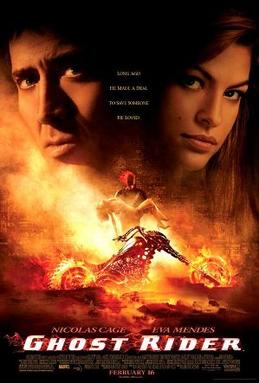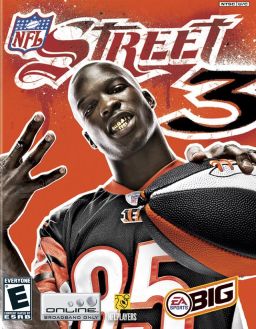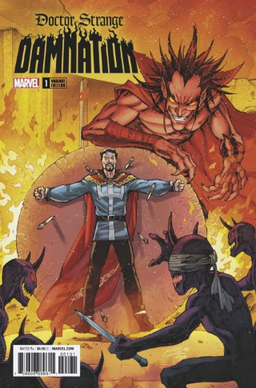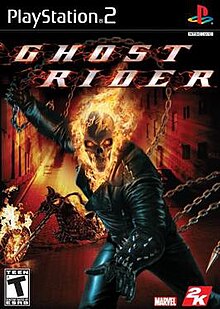
Ghost Rider is the name of multiple superheroes or antiheroes appearing in American comic books published by Marvel Comics. Marvel had previously used the name for a Western character whose name was later changed to Phantom Rider.

Mephisto is a fictional character appearing in American comic books published by Marvel Comics. The character first appeared in Silver Surfer #3, and was created by Stan Lee and John Buscema and based on Mephistopheles: a demon character from the Faust legend, who has sometimes been referred to as Mephisto. Introduced as a recurring adversary of the Silver Surfer and Ghost Rider, Mephisto has also endured as one of Spider-Man's most prominent adversaries, being responsible for Norman and Harry Osborn's respective transformations into the Green Goblin and Kindred; and for the superhero's loss of his marriage to Mary Jane Watson, considering their future daughter Spider-Girl his archenemy. Mephisto has often come into conflict with Doctor Strange, Doctor Doom, Scarlet Witch and other heroes of the Marvel Universe, being responsible both for the creation of the Cosmic Ghost Rider and the descents of Phil Coulson and Otto Octavius into villainy.

Blackheart is a fictional character appearing in American comic books published by Marvel Comics. The character is usually depicted as an adversary to the superhero Ghost Rider. Created by writer Ann Nocenti and artist John Romita Jr., Blackheart first appeared in Daredevil #270.

SSX on Tour is a snowboarding and skiing game, the fourth title in the SSX series of video games for the GameCube, PlayStation 2, Xbox and PlayStation Portable. It was released in North America on October 11, 2005 and in the PAL region on October 21, 2005. The PlayStation Portable version was released in Europe on October 28, 2005. In 2007, a prequel titled SSX Blur was released, which took place between SSX 3 and SSX on Tour. The GameCube version contains Mario, Luigi, and Princess Peach as playable characters. This was part of a deal Nintendo had with EA Sports to have Nintendo's intellectual properties appear in EA franchises.

MVP Baseball 2005 is a baseball video game developed by EA Canada and published by EA Sports. It features the Boston Red Sox left fielder, Manny Ramirez, on the cover. The game features the full Major League Baseball, Minor League Baseball, and Major League Baseball Players Association licenses. As with previous versions of the game, the announcers are Duane Kuiper and Mike Krukow, the real-life announcers for the San Francisco Giants.

Ghost Rider is a 2007 American superhero film written and directed by Mark Steven Johnson. Based on the Marvel Comics character of the same name, it was produced by Columbia Pictures in association with Marvel Entertainment, Crystal Sky Pictures, and Relativity Media, and distributed by Sony Pictures Releasing. The film stars Nicolas Cage as the titular character, with Eva Mendes, Wes Bentley, Sam Elliott, Donal Logue, Matt Long, and Peter Fonda in supporting roles. Johnny Blaze, a motorcycle stuntman sells his soul and becomes a bounty hunter of evil demons: the Ghost Rider.

Zarathos is a fictional character appearing in American comic books published by Marvel Comics. He is usually depicted in stories featuring the character known as the Ghost Rider. A demonic being who tortures and devours souls, Zarathos first appeared in Marvel Spotlight #5 and was created by writers Roy Thomas and Gary Friedrich and artist Mike Ploog.

The Midnight Sons are a fictional team of supernatural superheroes appearing in American comic books published by Marvel Comics. Including Ghost Riders Danny Ketch and Johnny Blaze, Blade, and Morbius, the original team first formed as part of the Rise of the Midnight Sons story arc, culminating in the first full team appearance in Ghost Rider #31. Following the success of the crossovers, Marvel branded all stories involving the group with a distinct family imprint and cover treatment, which lasted from December 1993 to August 1994. The team has been revived several times with different characters, but the most frequent members include Morbius, Blade, and at least one Spirit of Vengeance.

Pro Evolution Soccer 5, known as World Soccer: Winning Eleven 9 in Japan and North America, is a 2005 football sports simulation video game developed and produced by Konami as part of the Pro Evolution Soccer series.
Lilith is the name of two fictional characters appearing in American comic books published by Marvel Comics.

FIFA Street 2 is the 2006 sequel to the EA Sports video game FIFA Street. A new "trick stick beat" system was introduced and new authentic tricks were also introduced. The game was released for the GameCube, Nintendo DS, PlayStation 2, PSP, Xbox, and mobile phones. The player on the game cover is Portugal international Cristiano Ronaldo.

Pro Evolution Soccer 6, known as Winning Eleven: Pro Evolution Soccer 2007 in the United States, is a video game developed and published by Konami. Released in 2006 for the PlayStation 2, Xbox 360, and Microsoft Windows platforms and following on the Nintendo DS and PlayStation Portable afterward, Pro Evolution Soccer 6 is the 6th edition of the Pro Evolution Soccer series for the PlayStation 2, 2nd for the PlayStation Portable and 4th for Microsoft Windows. It is the first game to debut on the Nintendo DS and the Xbox 360. The Xbox 360 version features improved graphics, but retains gameplay similar to the other console versions. The edit mode has been stripped down for the Xbox 360 release, due to time restrictions. The graphics engine on the PC does not utilise the next-gen 360 engine but will again be a direct conversion of the PlayStation 2 engine.

Ghost Rider is a fictional character appearing in American comic books published by Marvel Comics. He is the second Marvel character to use the name Ghost Rider, following Carter Slade and preceding Daniel Ketch, Alejandra Jones, and Robbie Reyes. The character's story begins when motorcycle stuntman Johnny Blaze becomes bound to the Spirit of Vengeance Zarathos after making a deal with Mephisto to spare his surrogate father. With his supernatural powers, Johnny seeks vengeance as the "Ghost Rider".

Ghost Rider is a fictional character appearing in American comic books published by Marvel Comics. He is the third Marvel character to don the identity of Ghost Rider, after Johnny Blaze and the Western hero known as the Phantom Rider, who used the name in 1967.

Centurious is a fictional character appearing in American comic books published by Marvel Comics.

NFL Street 3 is the third installment of the NFL Street series, released in November 2006 for the PlayStation 2 and PlayStation Portable consoles. This installment features more game modes and unlockable features than previous versions. Chad Johnson of the Cincinnati Bengals appears on the cover and was the official spokesperson of the game.

Ghost Rider is the name of multiple comic book titles featuring the character Ghost Rider and published by Marvel Comics, beginning with the original Ghost Rider comic book series which debuted in 1967.

Ghost Rider: Spirit of Vengeance is a 2011 American superhero film based on the Marvel Comics antihero Ghost Rider. It is a sequel to the 2007 film Ghost Rider and features Nicolas Cage reprising his role as Johnny Blaze / Ghost Rider with supporting roles portrayed by Ciarán Hinds, Violante Placido, Johnny Whitworth, Christopher Lambert, and Idris Elba. The film was directed by Mark Neveldine and Brian Taylor, from a screenplay written by Scott M. Gimple, Seth Hoffman, and David S. Goyer. Released publicly for one night on December 11, 2011, Ghost Rider: Spirit of Vengeance had its wide commercial release on February 17, 2012, in 2D and 3D.

Blackout is a supervillain appearing in American comic books published by Marvel Comics. He is depicted as a half-demon, and is the second character to use The Name, an arcane blessing which bestows vampiric powers.

Damnation is a comic book limited series written by Donny Cates and Nick Spencer, illustrated by Rod Reis, and published in 2018 as four monthly issues by Marvel Comics. It was the main story in a crossover event with some plot elements occurring in tie-in issues of related ongoing series also published by Marvel.



















